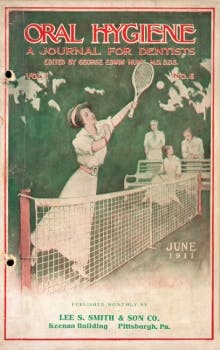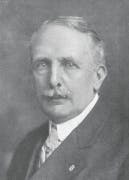Happy Birthday, Dental Economics®!
by Penny E. Anderson
Senior Editor
For more on this topic, go to www.dentaleconomics.com and search using the following key words: Dental Economics®, anniversary, Oral Hygiene, PennWell®, controlled circulation.
This year, Dental Economics® celebrates its 100th year of publication. That's quite an achievement for any magazine, but especially for a trade publication for dentists. In fact, no current magazine with a general circulation to dentists goes back as far.
Dental Economics® began its journey in 1911 as a publication called Oral Hygiene, the revolutionary idea of W. Linford Smith of Lee S. Smith and Co., a leading dental supply house and manufacturer's agent of the day.
Oral Hygiene became the first "controlled circulation" publication in the country, with circulation free to all dentists and the magazine itself supported by advertising. It was the first publication to blanket the field to which it was dedicated.
W. Linford Smith knew the undertaking was unprecedented, but despite advice to the contrary, he held firm to his conviction that broad circulation and a strong editorial concept would overcome any perceived objection to free distribution. Within 15 years, "free circulation" publications were being distributed in many other fields. Today, controlled circulation magazines and Web sites serve nearly every profession and special interest.
Headlines from the February 1911 issue indicate the strong "economic" emphasis of the magazine. "The Education of Mr. Tax Payer," "Paying of Accounts," "Extending the Field of Dentistry," and "Three Aspects of Dentistry – Professional, Business, and Commercial" graced that second issue.
The early editors
Dr. George E. Hunt served as the publication's first editor until his death in 1914. The founders, aware that the free distribution concept was "suspect" in the eyes of many, initiated a strict editorial code and sought the leading editorial writer of the time to head the editorial team. Hunt was dean of the Indiana Dental College and had previously served as editor of the Indiana Dental Journal. He was given complete editorial freedom, and great care was taken to maintain editorial integrity.
Dr. William Belcher of Rochester, N.Y., a regular contributor to the early issues, was the second editor, remaining in that post until his death in 1919. Dr. Rea Proctor McGee, a contributing editor to the publication, followed Dr. Belcher, and served as editor for 13 years. He was credited with the magazine "wielding a more powerful influence than it ever has in history."
McGee retired in 1932, and Dr. Arthur G. Smith became editor. An 1894 graduate of the Dental Department of Harvard University, Dr. Smith had practiced in his hometown of Peoria, Ill., and had served for several years as editor of the bulletin of the Illinois State Dental Society.
In 1934, Dr. Edward J. Ryan began his tenure of nearly 30 years as editor of Oral Hygiene. A well known past officer of the Chicago Dental Society, he had served as editor of Dental Digest, a sister publication, for two years. The editorial office was reestablished in Evanston, Ill., and Dr. Ryan served as the magazine's editor until his death following a brief illness in 1963.
Dr. E. James Best, also from Evanston, then began a 10-year stint as editor, and the editorial office remained in Evanston. He was a graduate of the Loyola University School of Dentistry, and he spent mornings at his practice and afternoons across the street in Oral Hygiene's editorial office. He also served as chief of dental services at a hospital and a professor of endodontics at Loyola and Northwestern.
The name changes
It was during this era that the name of the magazine changed. On Jan. 1, 1967, the banner read, Oral Hygiene/Dental Economics. A year later, the title was Dental Economics/Oral Hygiene, and on Jan. 1, 1969, the name Dental Economics® stood alone, although the phrase "founded in 1911 as Oral Hygiene" remained in the masthead.
On Jan. 1, 1970, another "look" was presented to readers as the magazine changed from digest size to the standard magazine page size and format.
Sixty years in Pittsburgh
While the editorial office was in Evanston, the publishing headquarters remained in Pittsburgh. During the 60 years the magazine was published in Pittsburgh, only three men carried the title of publisher. The founder, W. Linford Smith, served in that position until his death in 1925. At that time, Merwin B. Massol, business manager since 1920, became publisher. He retained that role until bad health forced his retirement in 1963. His "Publisher's Corner" column was a regular feature for 40 years.
In 1963, Robert C. Ketterer, who started his career with the publication in 1933, continued "Publisher's Corner," authoring 144 columns before retiring when the magazine moved to Tulsa, Okla., in 1971.
Petroleum Publishing comes calling
The only change in ownership of the publication in its first 75 years took place in 1971 when PennWell® (then called Petroleum Publishing Co.) purchased the magazine and moved the publishing office to Tulsa, Okla. This was PPC's first major acquisition outside of the petroleum market. Dr. Best continued as the magazine's editor and remained in the Evanston editorial office.
In 1973, the editorial office was moved to Tulsa, prompting Dr. Best to step aside as editor. Dick Henn, an experienced medical magazine journalist, was named editor, a position he held until 1977.
The move to Tulsa prompted other changes in the structure of the magazine. Publisher Joe Wolking, who was later to become president of PennWell®, wanted to ensure that the magazine remained relevant to its readers. He was at the helm during the transition from Pittsburgh and Evanston, and then to Tulsa. He initiated an editorial board of actively practicing dentists to counsel the editorial staff and review all articles.
Wolking became vice president of PennWell® in 1975, and Joe Bessette came on board as the new publisher of DE. One of the founders of Physician's Management, Bessette expanded the advertising sales efforts and role of the editorial board.
In late 1977, Henn moved to another field, and Bessette named assistant editor Pat Muchmore, who had been on the staff since 1975, as the new editor of DE. Her tireless efforts, journalistic skills, and high standards and goals came at a time when the magazine was experiencing exceptional growth. She moved the focus of the magazine even more into coverage of socioeconomic issues.
A new staff builds
One of today's sales staff members was already at work on the magazine and, in fact, made the move from Pittsburgh. Marv Ashworth began his career with the magazine in 1960 and has served in many different capacities over the years. When the magazine moved to Tulsa in 1971, he was the production manager. Marv is currently Midwest/Southeast sales manager for Dental Economics® and its sister publication, Proofs®.
Senior Editor Penny E. Anderson, a journalist with 14 years of experience in newspaper, public relations, and technical writing, joined the editorial staff in 1979. This allowed the magazine to place increasing emphasis on staff-written and researched articles.
Associate Editor Vicki Cheeseman was a teenager when she started working for DE in 1980. Vicki worked summers during high school and college as an editorial assistant. She graduated from college with a degree in mathematics, and went to work for a research and development company. But she loved working for the magazine and came back when a full-time editorial assistant position opened in 1987. She became business manager in 1993, a position she held until returning to the editorial side in 2000.
In 1982, Pat Muchmore chose to get away from the rigors of magazine deadlines to spend more time with her husband. She turned the editorial reins over to Dick Hale, a journalist who had published community newspapers for 19 years and edited national association magazines for eight years prior to moving to Dental Economics®. He continued Muchmore's focus on staff-written articles and socio-economic issues. He was later named publisher, and Roger Harway, a long-time independent sales rep for DE, was named associate publisher. Harway's father, Don Harway, became a sales rep for Dental Economics® in 1982, and Roger took over the business when Don retired.
In 1997, Dick Hale and Roger Harway retired, and DE went back to its origins in naming a practicing dentist, Dr. Joe Blaes, as editor of Dental Economics®. Named as publisher was Lyle Hoyt, who had been with the magazine since June of 1995 as West Coast sales manager. Hoyt is currently senior vice president and division general manager of PennWell®.
Rounding out the current staff are Kevin Henry, managing editor; Duane DaPron, associate editor; and Meg Kaiser, assistant editor. Mark Hartley, who came to the dental division as editor of sister publication RDH® magazine in 1995, is chief editor over all dental publications.
Dr. Blaes changed the format of DE to include more information about the growing new technologies and changing focus of dental practices. Cosmetic dentistry was a growing aspect of dentistry, and with it came a host of new and ever-changing products and technology. Dr. Blaes, who was and continues to be a national speaker on both practice management and clinical topics, has put an emphasis on new products with his "Pearls For Your Practice®" column, and has launched regular new columns on topics important to dentists such as implants, financial planning, practice success, laser technology, and much more. Dr. Blaes has also refocused the magazine to include articles written by dentists and dental consultants.
In 2006, PennWell® acquired the publishing and continuing-education business of the Academy of Dental Therapeutics and Stomatology® and Odontos World Media from the company's founder and president, Michael Florman, DDS. ADTS is a leading provider of continuing education publications and courses for the dental profession. ADTS is authorized by the American Dental Association to provide continuing education credits to dentists, hygienists, and dental assistants in the U.S.
Aldo Eagle, Florman's partner and vice president of ADTS since 2004, joined PennWell® as sales director of the business, reporting to Lyle Hoyt. This acquisition brought into the PennWell® network authors and trainers to create continuing-education courses that are compelling and topical for dentists and hygienists, who must meet certain educational requirements each year. Eagle is now vice president, continuing education, and associate publisher of Dental Economics®.
The continuing challenge
The bulk of the credit for the success of DE must go to its readers and advertisers. Readership studies continue to verify the need for the magazine and its acceptance by dentists. The continual support that dentists give to the advertisers truly makes this publication possible.
As we continue the move into the digital age with the addition of our Web sites, e-newsletters, and Web-based virtual shows – as well as our emphasis on trade shows and continuing education – we find new and expanded ways to reach dentists with the information they need in a format of their choice.
The goal of the magazine, trade shows, and Web-based efforts will continue to be helping dentists meet the challenges and changes in their professional and personal lives to achieve success.



